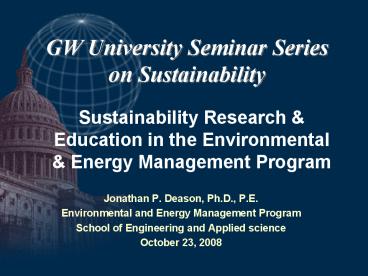GW University Seminar Series on Sustainability
1 / 29
Title:
GW University Seminar Series on Sustainability
Description:
GW University Seminar Series on Sustainability –
Number of Views:39
Avg rating:3.0/5.0
Title: GW University Seminar Series on Sustainability
1
GW University Seminar Series on Sustainability
Sustainability Research Education in the
Environmental Energy Management Program
- Jonathan P. Deason, Ph.D., P.E.
- Environmental and Energy Management Program
- School of Engineering and Applied science
- October 23, 2008
2
- Recent Sustainability-Focused Research Projects
3
Project 1Hydrogen Production Alternatives
Resolving Disparities and Examining the Stability
of Decision Making Amongst Divergent Stakeholders
- Dr. Elvin Yuzugullu
- SenTech Corporation
4
Summary
- Determination of national energy objectives
hierarchy - Assessment of utility functions among disparate
stakeholders - Assessment of capability of MCDM to facilitate
convergence of disparate viewpoints
5
Development of Objectives Hierarchy
- Based on literature survey, an illustrative
objectives hierarchy was presented to SMEs, with
criteria considered relevant - SMEs responded to survey in order to determine
objectives hierarchy, based on their knowledge
and experience - Decision makers also asked to rank the criteria
they have determined
6
Selection of Criteria
- Objectives hierarchy preferences indicated by
decision makers analyzed and organized - Rankings provided by decision makers
- A set of relevant and important criteria, with
optimum level of detail determined
7
Specification of Weights
- Second survey presented to decision makers in
several rounds - Provide judgments on weights for the criteria
- Consider judgments of other decision makers
- /kg H2 values presented for to assist judgments
8
Model Evaluation
- Test beds for model evaluation
- Steam methane reformation of natural gas
- Wind electrolysis
- Data from economic, life-cycle environmental and
environmental valuation studies - Interactions with SMEs to obtain judgment on key
aspects of model
9
Published Results
Yuzugullu, E. and Deason, J.P, Structuring
Objectives to Facilitate Convergence of Divergent
Opinion in Hydrogen Production Decisions, Energy
Policy Journal, 35 (2007), pp. 452-460
10
Project 2 Closing the Gap Between Socioeconomic
and Financial Implications of Residential and
Community Level HydrogenBased Energy Systems
Incentives Needed for a Bridge to the Future
- Dr. Laura Verduzco
- Chevron Corporation
11
Summary
- National Academy of Engineering (2004) in the
committees vision of a possible hydrogen future,
the demand for hydrogen will likely be met using
distributed production during the first couple of
decades of transition. - Problem How to determine (1) optimal scale of
distributed hydrogen production and (2) optimal
level of incentives that should be put into place
to encourage small-scale production facilities - Research Approach Multi-aspect analyses of three
major production alternatives conventional
(baseline), Home Refueling Units and
Neighborhood/Community Refueling Units
12
HRU and NRU Prototypes
Home Energy Station Prototype
Solar Powered Water Electrolyzing Hydrogen
Station
13
Comparison of NPVs Using Simulation
Calculate multiple scenarios by repeatedly
sampling values from the probability
distributions
14
Comparing the Results
Offer 1500 in tax credits?
This is what the developer pays
How can we make options two and three more
attractive for the developer? Economic
incentives tax credits, subsidies, etc.
15
Sensitivity Analysis
Model uncertainty of the critical variables
Capital Investment
Tax Incentives
500 1000 1500
16
Published Results
Verduzco, Laura E., Duffey, M.R. and Deason.
J.P., H2Power Development of a Methodology to
Calculate Life Cycle Costing of Small and
Medium-Scale Hydrogen Systems, Energy Policy
Journal, accepted for publication on April 24,
2006
17
Project 3The Energy Policy Act of 1992 and
Executive Order 13149 Proposed Compliance
Strategies and Process Improvements for Federal
Agencies
- Dr. Michael Helwig
- National Renewable Energy Laboratory
18
Summary
- Problem Twenty agencies examined nine out of
compliance large agencies tend to be less
compliant - Research Approach Development of tiered integer
optimization programs to maximize EPAct AFV
credits, subject to budget constraints,
alternative fuel availability, vehicle
availability, fleet needs, etc.
19
Agency Compliance
20
Solution Tiered Set of Smart Optimization
Programs
- Integer optimization programs that maximize EPAct
AFV credits, subject to - Budget constraints
- Alternative fuel and vehicle availability
- Fleet needs/desires
21
Published Results
Helwig, M. and Deason, J.P., The Energy Policy
Act of 1992 and Executive Order 13149 Proposed
Compliance Strategies and Process Improvements
for Federal Agencies, Energy Policy Journal, 35
(2007), pp. 2,912-2,924
22
- Current Sustainability-Focused Research Projects
23
- A Predictive Risk Modeling System for the
Management of Small-Scale Water and Wastewater
Facilities Toward Long-Term Sustainability of
Our National Parks
24
- A Decision-Aiding Model for Leaking Underground
Storage Tank Remediation Programs
25
- Social, Economic, and Environmental
Sustainability Metrics for Large Organizations
26
- Comparative Analysis of the Use of Quantitative
Risk Assessment in Environmental Applications
Involving Radiological Hazards at U.S. Federal
Government Agencies
27
A Linear Programming Model to Support Development
and Maintenance of a Solar Grand Plan Deployment
Schedule
28
- Analysis of Solar Energy Transition Potential of
Department of Defense Facilities and Non-Tactical
Vehicles
29
- Discussion































